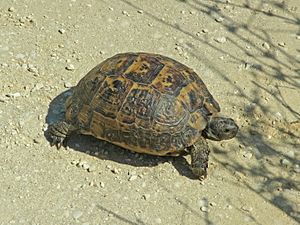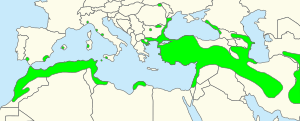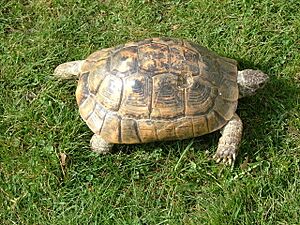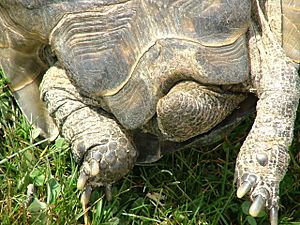Greek tortoise facts for kids
Quick facts for kids Greek tortoise |
|
|---|---|
 |
|
| Photographed in Greece | |
| Conservation status | |
| Scientific classification | |
| Genus: |
Testudo
|
| Species: |
graeca
|
 |
|
| Note allopatric ranges of "Maghreb" (T. g. graeca) and "Greek" (T. g. ibera) populations | |
| Synonyms | |
|
List
T. g. graeca
Testudo graeca Linnaeus, 1758 Testudo pusilla Linnaeus, 1758 Chersine pusilla — Merrem, 1820 Testudo mauritanica A.M.C. Duméril & Bibron, 1835 Testudo mauritonica Kercado, 1835 (ex errore) Testudo whitei Bennett, 1836 Peltastes mauritanicus — Gray, 1873 Testudo graeca graeca — Mertens, 1946 Testudo gracea Nutaphand, 1979 (ex errore) Testudo whitie Highfield & Martin, 1989 (ex errore) Furculachelys whitei — Highfield, 1990 Testudo graeca sarda Ballasina, 1995 (nomen nudum) Testudo graeca whitei — Artner, 1996 T. g. anamurensis Testudo graeca anamurensis Weissinger, 1987 Testudo ibera anamurensis — Highfield, 1990 Testudo terrestris anamurensis — David, 1994 Testudo anamurensis — Vetter, 2002 Testudo graeca amurensis Ferri, 2002 (ex errore) T. g. antakyensis Testudo antakyensis Perälä, 1996 Testudo graeca antakyensis — Zwartepoorte, 2000 Testudo terrestris antakyensis — Bour, 2002 Testudo ibera antakyensis — Artner, 2003 T. g. armeniaca Testudo graeca armeniaca Chkhikvadze, 1989 (nomen nudum) Testudo graeca armeniaca Chkhikvadze & Bakradze, 1991 Testudo graeca armaniaca Chkhikvadze & Bakradze, 1991 (ex errore) Testudo armeniaca — Vetter, 2002 Testudo terrestris armeniaca — Bour, 2002 T. g. buxtoni ? Testudo ecaudata Pallas, 1814 Testudo buxtoni Boulenger, 1921 Testudo terrestris buxtoni — Bour, 2002 Testudo ibera buxtoni — Artner, 2003 ; T. g. cyrenaica Testudo graeca cyrenaica Pieh & Perälä, 2002 Testudo cyrenaica — Vetter, 2002 Testudo cyrenaika Stettner, 2004 (ex errore) T. g. floweri Testudo floweri Bodenheimer, 1935 Testudo graeca floweri — Mertens, 1946 Testudo terrestris floweri — David, 1994 Testudo ibera floweri — Artner, 2003 T. g. ibera Testudo ibera Pallas, 1814 Chersus iberus — Brandt, 1852 Testudo iberia Blyth, 1853 (ex errore) Medaestia ibera — Wussow, 1916 |
|
The Greek tortoise (Testudo graeca), also known as the spur-thighed tortoise, is a type of tortoise. It belongs to the family Testudinidae. This tortoise is one of five species found in the Mediterranean region.
The other four species are Hermann's tortoise (T. hermanni), the Egyptian tortoise (T. kleinmanni), the marginated tortoise (T. marginata), and the Russian tortoise (A. horsfieldii). Greek tortoises can live for a very long time, often over 125 years. Some unconfirmed reports suggest they can live up to 200 years!
Contents
Where Do Greek Tortoises Live?
The Greek tortoise lives across a wide area. You can find them in North Africa, Southern Europe, and Southwest Asia. They are common along the Black Sea coast in places like Russia and Georgia. They also live in Armenia, Iran, and Azerbaijan.
How Greek Tortoises Evolved
The oldest clear fossil of a Greek tortoise is from the Early Pliocene period in Greece. This means they have been around for millions of years. Some older fossils from the Late and Middle Miocene in Greece and Turkey might also be related to this species.
What Makes a Greek Tortoise Special?
It's easy to confuse the Greek tortoise (T. g. ibera) with Hermann's tortoise (T. hermanni). But there are some key differences that help tell them apart.
| Greek Tortoise | Hermann's Tortoise |
|---|---|
| Has large, even markings on its head | Only small scales on its head |
| Has large scales on its front legs | Has small scales on its front legs |
| The shell over its tail is usually one piece | The shell over its tail is almost always split |
| Has clear spurs on each thigh (upper leg) | Does not have spurs on its thighs |
| Has spots on its spine and rib plates | Only has spots on its spinal plates |
| Has a dark spot in the middle of its underside | Has two black stripes on its underside |
| Its shell is somewhat rectangular | Its shell is oval-shaped |
| Its spinal plates are wide | Its spinal plates are small |
| The back plates on its underside can move | The plates on its underside are fixed |
| Does not have a spur on the tip of its tail | Has a spur on the tip of its tail |
Types of Greek Tortoises (Subspecies)
It can be tricky to divide the Greek tortoise into different types, called subspecies. They live in so many different places with various climates and landscapes. This has led to many different varieties. New subspecies are still being found!
Currently, there are at least 20 known subspecies. Some examples include:
- T. g. graeca (found in North Africa and Southern Spain)
- T. g. nabeulensis - also known as the Tunisian tortoise (from Tunisia)
- T. g. ibera (found in Turkey)
- T. g. armeniaca - also known as the Armenian tortoise (from Armenia)
These different types vary mainly in their size, weight, and color. Their colors can range from dark brown to bright yellow. Some have solid colors, while others have many spots. The edges of their shells (called carapaces) can also bend up differently.
The smallest subspecies is the Tunisian tortoise. It has very bright and pretty colors. However, these tortoises are also the most sensitive. They cannot be kept outside in cooler climates. Cold, rainy summers can make them sick. They also cannot hibernate for long periods.
On the other hand, tortoises from northeastern Turkey are very strong. The largest Greek tortoises come from Bulgaria. Some have been reported to weigh up to 7 kg (15 lb). In contrast, the Tunisian tortoise weighs a maximum of only 0.7 kg (1.5 lb).
Greek tortoises are also closely related to the marginated tortoise (T. marginata). These two species can even have babies together, and those babies can also have their own offspring.
How to Tell Male and Female Tortoises Apart
Male Greek tortoises are different from females in a few ways:
- Males are usually smaller than females.
- Their tails are longer and get thinner towards the end. The opening for waste (cloaca) is further from the tail's base.
- The underside of a male's shell is slightly curved. Females have a flat underside.
- The back part of a male's upper shell is wider than it is long.
- The plates at the very back of a male's upper shell often stick out.
Reproduction and Life Cycle
Right after waking up from their winter sleep (hibernation), Greek tortoises start looking for mates. Males will follow females, circle them, and gently bite their legs.
About one or two weeks before laying eggs, the female tortoises become very active. They move around, sniffing and digging in the soil. They even taste the soil to find the perfect spot to lay their eggs.
Protecting Greek Tortoises
Greek tortoises are often sold as pets in countries like Morocco and Spain. This trade is actually against the law. Taking too many tortoises from the wild can harm their populations. Also, these tortoises are often not kept well when they are being sold. This causes many of them to get sick or die in captivity.
What Greek Tortoises Eat
Greek tortoises love to eat dandelion leaves and other leafy plants. They also enjoy lettuce, but lettuce isn't the best food for them. It doesn't have enough of the important nutrients they need to stay healthy.
Images for kids
See also
 In Spanish: Tortuga Mora para niños
In Spanish: Tortuga Mora para niños






